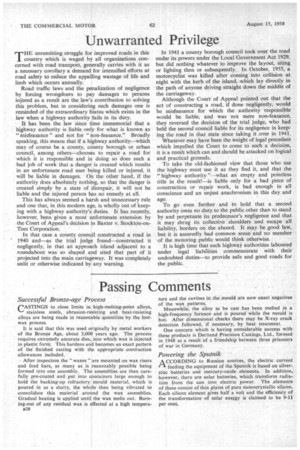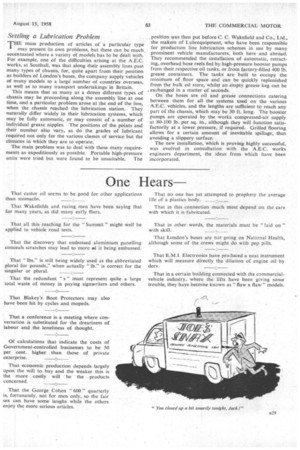Passing Comments
Page 34

Page 35

If you've noticed an error in this article please click here to report it so we can fix it.
Successful Bronze-age Process
rASTINGS to close limits in high-melting-point alloys, stainless steels, abrasion-resisting and heat-resisting alloys are being made in reasonablequantities by the lostwax process.
It is said that this was used originally by metal workers of the Bronze Age, about 3,000 years ago. The process requires extremely accurate dies, into which wax is injected in plastic form. This hardens and becomes an exact pattern of the finished casting with the appropriate contraction allowances included.
• After inspection the " waxes " are mounted on wax risers and feed bars, as many as is reasonably possible being formed into one assembly. The assemblies are then carefully pre-coated and put into containers large enough to hold the backing-up refractory mould material, which is poured in as a slurry, the whole then being vibrated to consolidate this material around the wax assemblies. Gradual heating is applied until the wax melts out. Burning-out of any residual wax is effected at a high tempera
B28 ture and the cavities in the mould are now exact negatives of the wax patterns.
Meanwhile, the alloy to be cast has been melted in a high-frequency furnace and is poured while the mould is hot. After dimensional checks there may be X-ray crack detection followed, if necessary, by heat treatment.
One concern which is having considerable success with these products is Deritend Precision Castings, Ltd., formed in 1948 as a result of a friendship between three prisoners of ,war. in Germany.
Powering the Sputnik
ACCORDING to Russian sources, the electric current " feeding the equipment of the Sputnik is based on silverzinc batteries and mercury-oxide elements. In addition, however, there are solar batteries, which transform radiation from the sun into electric power. The elements of these consist of thin plates of pure monocrystallic silicon. Each silicon element gives half a volt and the efficiency of the transformation of solar energy is claimed to be 9-11 per cent.
Settling a Lubrication Problem
THE mass production of articles of a particular type
may present its own problems, but these can be much accentuated where a variety Of models has to be dealt with. For example, one of the difficulties arising at the A.E.C. works, at Southall, was that along their assembly tines pass many types of chassis, for, quite apart from their position as builders of London's buses, the company supply vehicles of many models to a large number of countries overseas, as well as to many transport undertakings in Britain.
This means that as many as a dozen different types of chassis may be proceeding along the assembly line at one time, and a particular problem arose at the end of the line, when the chassis reached the lubrication station. They naturally differ widely in their lubrication systems, which may be fully automatic, or may consist of a number of individual grease nipples. The positions of the points and their number also vary, as do the grades of lubricant required not only for the various classes of service but the climates in which they are to operate.
The main problem was to deal with these many requirements as expeditiously as possible. Portable high-pressure units were tried but were found to be unsuitable. The position was then put before C. C. Wakefield and Co., Ltd., the makers of Lubrequipment, who have been responsible for production line lubrication schernes in use by many prominent vehicle manufacturers, both hereand abroad. They recommended the installation of automatic, retracting,.overhead hose reels fed by high-pressure booster pumps from their respective oil tanks, or from factory-filled 400 lb. grease containers. The tanks are built to occupy the minimum of floor space and can be quickly replenished from the bulk oil store, whilst an empty grease keg can be , exchanged in a matter of seconds.
On the hoses are oil and grease connections catering between them for all the systems used on the various A.E.C. vehicles, and the lengths are sufficient to reach any part of the chassis, which may be 30 ft. long. The booster pumps are operated by the works compressed-air supply at 80-100 lb. per sq. in., although they will function satisfactorily at a lower pressure, if required. Grilled flooring allows for a certain amount of inevitable spillage, thus avoiding a slippery surface.
The new installation, which is proving highly successful, was evolved in consultation with the A.E.C. works engineers department, the ideas from which have been incorporated.












































































































